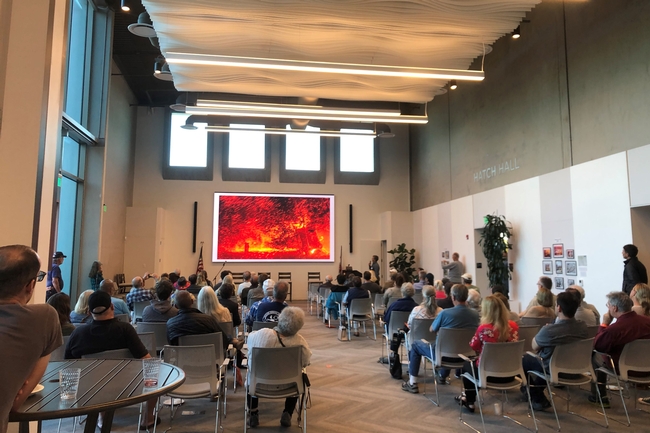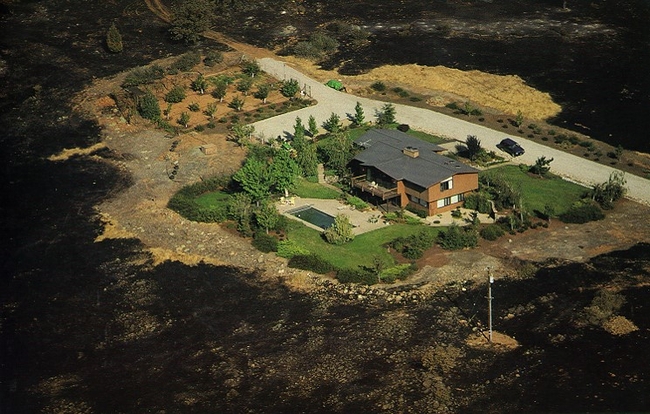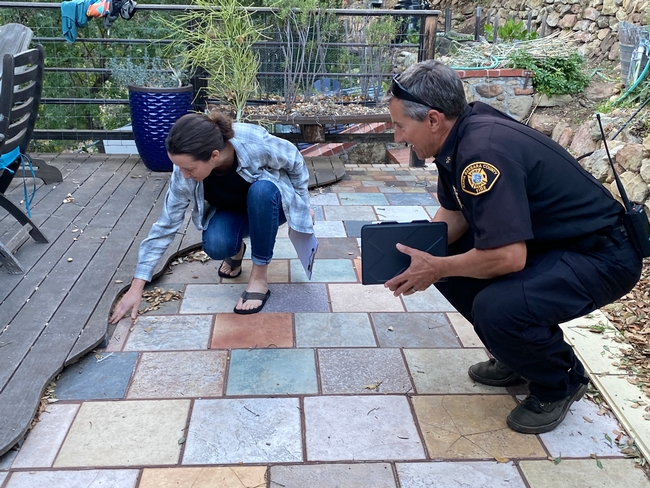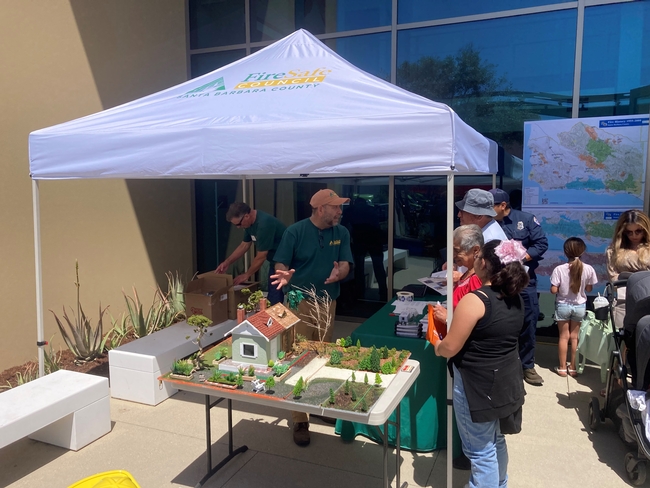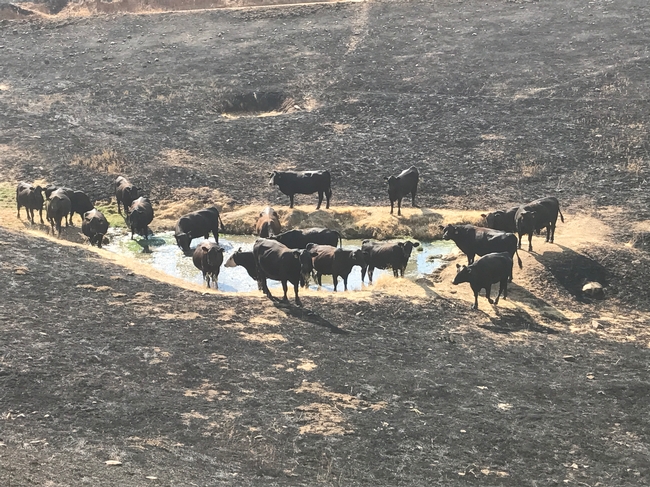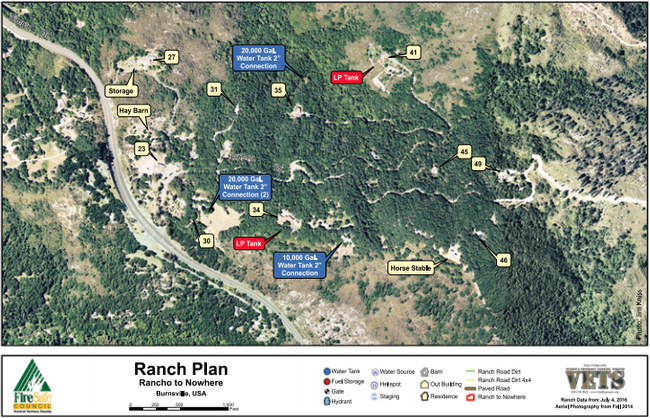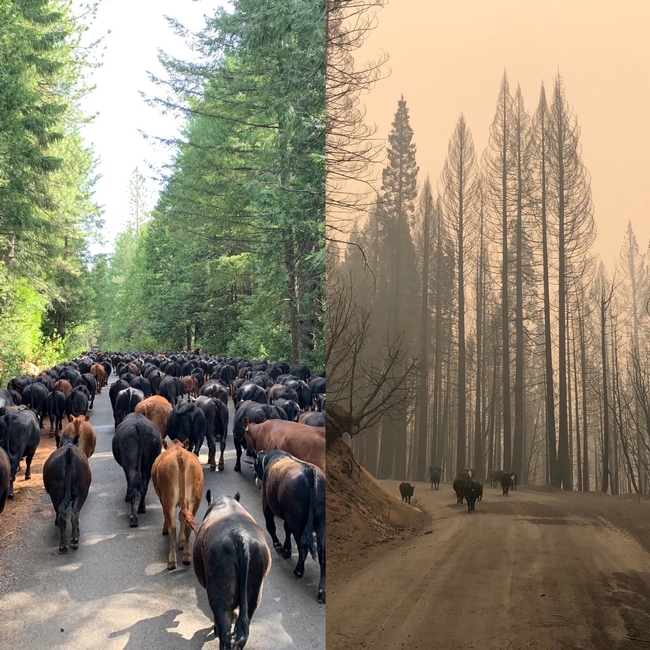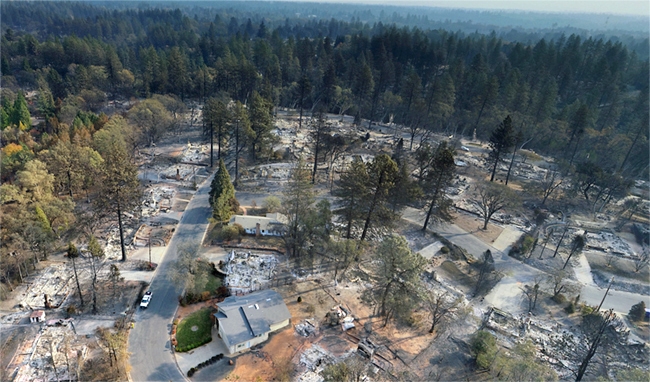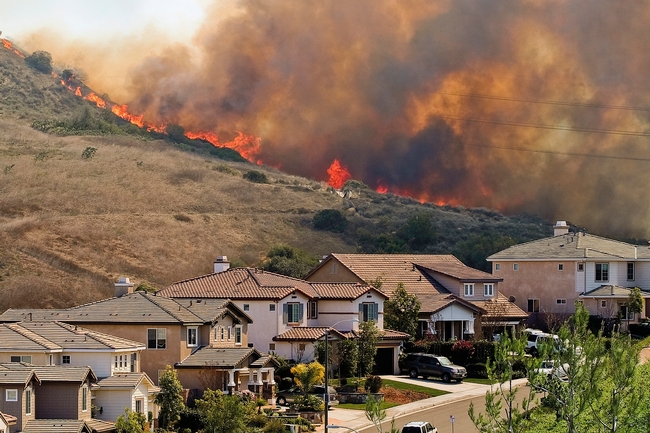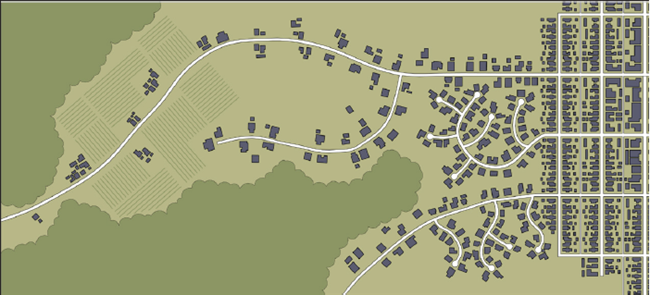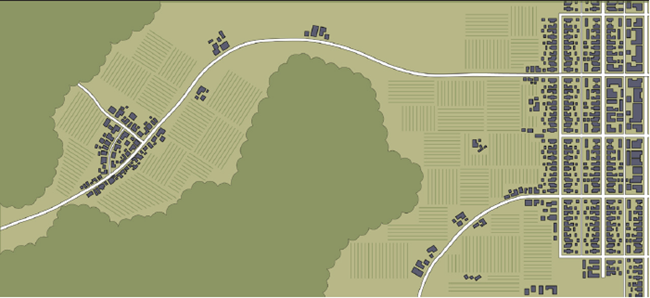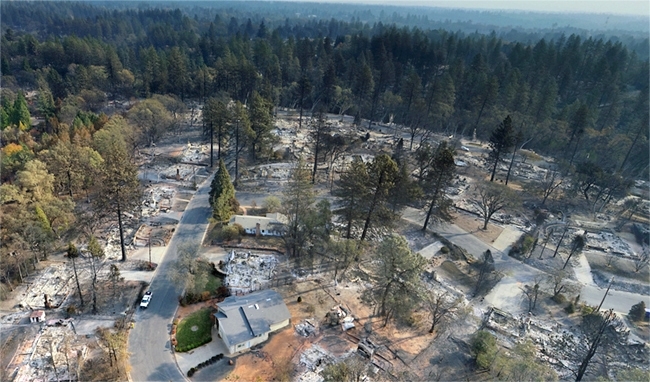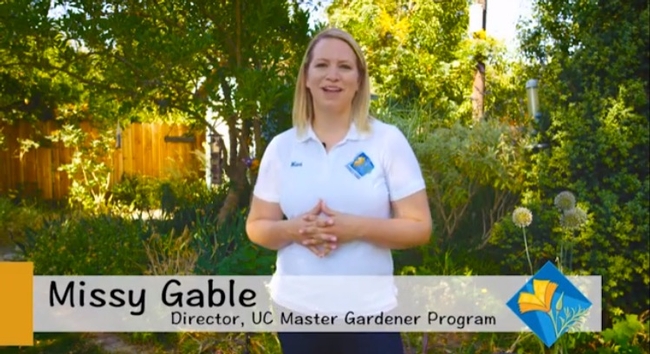
Posts Tagged: Max Moritz
Study: Regional approach to wildfire more comprehensive, equitable
Pilot program in Santa Barbara County shows promise for bolstering resilience
After a rash of wildfires across Southern California in 2003, many counties, cities and neighborhoods adopted Community Wildfire Protection Plans to improve their preparedness and fire response. But Rob Hazard, fire marshal for Santa Barbara County, has noticed that CWPPs and resources are unevenly distributed across areas at high risk of wildfire.
“Communities that are more affluent, more white, they are the ones that end up getting the grants, they're the ones that end up getting the projects to mitigate risks,” Hazard said, “whereas more disadvantaged communities…often don't have the organization to make that happen, or maybe it's not the most pressing issue of the moment.”
Mapping those underserved communities – and ensuring they have a more equitable share of attention – are some of the goals of a new, more comprehensive approach to wildfire, currently being piloted in Santa Barbara County. This “Regional Wildfire Mitigation Program” aims to fill in many of the gaps left by CWPPs, which tend to have a more narrow focus on fuel reductions for a specific locality.
“They certainly have their role and benefits, but CWPPs are pretty limited in scope,” said Max Moritz, University of California Cooperative Extension's statewide wildfire specialist. “They're really focused on modeling and prioritizing fuel breaks, and they leave all of these other aspects of our fire problem – our vulnerabilities, our potential losses – unaddressed.”
Moritz is the lead author of a recently published research article that describes the Regional Wildfire Mitigation Program's three key areas (or “domains”) for wildfire mitigation work: the built environment (pinpointing and addressing needs in buildings/infrastructure), landscape (creating buffers through land use policies and management choices), and community (educating the public on home hardening and other issues).
“It's this holistic approach that combines all of these elements, and each one of those elements speak to each other – they can't be independent,” said Hazard, a study co-author.
Seeking a better way
After the Thomas Fire devastated the region in 2017-18 and triggered deadly mudslides in Montecito, Moritz – an adjunct professor at UC Santa Barbara's Bren School of Environmental Science & Management – sought more encompassing risk mapping and mitigation solutions that could complement CWPP efforts.
He got together with Hazard, who began his career as a “hotshot crew” firefighter with the U.S. Forest Service and has been with Santa Barbara County Fire Department for nearly 25 years.
“Both of us believe: Yes, it is home hardening – but it's also defensible space, but it's also some fuel treatments, but it's also some prescribed fire, but it's also some agricultural belt (to create a buffer),” said Hazard. “We looked at it objectively, and in every community in Santa Barbara County there's something that either works – or doesn't.”
By the end of the pilot program along the south coast of Santa Barbara County, the team hopes to have refined a “decision support system” that other communities across the state – and perhaps around the globe – could use. The framework would incorporate their localized risk assessment data and conditions to help generate lists of prioritized projects across the three “domains” of wildfire mitigation.
The ability to adapt to new data and continual changes in ecosystems, communities and climate is another advantage of the RWMP. Unlike a “plan” that tends to be a one-off with a defined start and end date, this wildfire mitigation “program” is designed to pivot and evolve as conditions change. The goal is to motivate and guide implementation of risk mitigation activities in each domain.
“The program is a living program, so it's not going to be some PDF that sits on a server somewhere,” Hazard said.
One of the early lessons from the RWMP pilot has been that – aside from funding – a crucial factor in maintaining the momentum of a wildfire mitigation program is the presence of a dedicated group of community members.
“In each community, we'll need a group that is ready to take this on and spearhead it and run with it,” Moritz said. “In many communities, that will probably be the Fire Safe Council.”
Building ‘Firewise' communities
Local Fire Safe Councils are “grassroots, community-led organizations that mobilize residents to protect their homes, communities and environments from catastrophic wildfire,” according to the California Fire Safe Council.
And while Moritz, Hazard and other experts serve on the volunteer Board of Directors for Santa Barbara County Fire Safe Council, they soon realized that they needed to hire staff to perform the “community domain” work of educating and reaching out to residents.
A $5 million grant from the National Fish and Wildlife Foundation for the RWMP project helped build the capacity of the council, which hired its first staff member, Anne-Marie Parkinson, last fall.
“A lot of people underestimate how important it is to have community activists or leaders who take on the role and responsibility of organizing people, being the point of contact, rallying people to do activities or work days,” said Parkinson, a graduate of UCSB's Bren School and a co-author of the RWMP study.
Parkinson has been working to get communities recognized by Firewise USA, a program of the National Fire Protection Association to organize residents in bolstering wildfire preparedness and reducing risk.
Although she has been encouraged by the awareness and activism among the community members she has met, Parkinson also hears from residents about the need for more resilient power and communications networks – concerns that could be better addressed by consolidating those requests with a regional approach.
“As we work with more and more communities, you can start to map which communities want better telecommunications, and which communities would benefit from a fuel break around them, and then we could write a grant that benefits five communities, instead of one small grant for one community,” Parkinson said.
Moving forward
There are many communities in fire-prone environments that are in need of help, and climate change makes their situation increasingly urgent, Moritz said, and a new and comprehensive framework – the RWMP – now exists for assessing and mitigating multiple risks.
“Every community has its own unique fire hazards and its own unique spatial layout of neighborhoods and vulnerabilities inherent to those neighborhoods,” he said. “But despite the uniqueness of each community and each region, I'm hoping this will provide a somewhat systematic way to approach making progress and mitigating a whole suite of risks.”
Other authors of the article are Kelly Johnston, Molly Mowery and Katie Oran of the Community Wildfire Planning Center; Marc Mayes of Spatial Informatics Group-Natural Assets Lab and UC Santa Barbara Earth Research Institute; Graham Wesolowski of Spatial Informatics Group-Natural Assets Lab; and David Schmidt of Spatial Informatics Group. The article is published in Frontiers in Forests and Global Change at https://www.frontiersin.org/articles/10.3389/ffgc.2022.848254/full.
People interested in learning more about the RWMP approach are encouraged to contact Graham Wesolowski at gwesolowski@sig-nal.org or Max Moritz at mmoritz@bren.ucsb.edu.
Ag Pass program aims to improve wildfire preparedness on rangeland
When the Detwiler Fire broke out near his family's ranch in 2017, Tony Toso was home to take defensive action to protect his family and animals. The Mariposa County rancher feels fortunate that he was on site.
“We were on the front end of the fire damage and it started on a Sunday,” recalled Toso. “Had I not been home that day, it would have been very difficult for me to access my property and help keep our livestock safe. Within a matter of hours of the fire starting, the CHP had our county road closed and would not let anyone in.”
Emergency personnel close roads around wildfires for the safety of people and to prevent them from impeding fire suppression efforts. When fire threatens large ranching operations, ranchers need to move their livestock out of harm's way and make sure they have feed and water. While volunteer groups can assist in rescuing dogs, cats, and a few sheep or horses, they don't have a rancher's knowledge, expertise and experience that are essential for managing hundreds of cattle at large-scale ranching operations.
To help rural communities prepare for wildfire, it would be helpful for farmers and ranchers to have a plan in place to coordinate with first responders, according to Max Moritz, UC Cooperative Extension wildfire specialist. Ag Pass is a program developed in Ventura County to identify farmers and ranchers to firefighters, law enforcement and other emergency personnel so they can allow them onto their property to rescue animals and identify access roads and water sources.
“Because fires are increasingly impacting people and are not going away anytime soon, we need to figure out approaches to sustainably live on fire-prone landscapes. In a broader sense, the Ag Pass is another way that we can adapt to, and coexist with, wildfire,” Moritz said.
Matthew Shapero, UC Cooperative Extension livestock and range advisor, and Moritz have written a publication to guide people who would like to create an Ag Pass Program for wildfire preparedness in their own locale.
“Our neighbors had cattle just north of us and they tried to get in and could not,” said Toso. “An Ag Pass in that situation, would have been a huge benefit had I not been at home and then wanted to access my property.”
In Ventura County, agricultural workers can apply for identification cards from the Central Ventura County Fire Safe Council, which verifies farm information through the county's pesticide applicator permit database. Ag Pass members provide detailed maps of their farms that show access roads – including many that don't show up on other maps.
Shapero, who works in Ventura and Santa Barbara counties, has been working with ranchers and county agencies to create an Ag Pass program in Santa Barbara County.
“The last few fire seasons have made a program like the Ag Pass more urgent than ever, especially as awareness of wildfire's impacts to agriculture has grown,” Shapero said. “We hope that this publication provides localities with a workable blueprint that will expedite the adoption of this or similar programs.”
Shapero has been working with Anthony Stornetta of Santa Barbara County Fire and representatives of other agencies to develop a training for Ag Pass participants in Santa Barbara County.
“After being at the Carr, Sonoma, Creek and Camp fires for months at a time, I started developing the program from the fire side and presented it to California Cattlemen's Association a couple years ago,” Stornetta. “This was a great collaborative effort. After meeting with our fire safe council, we are looking at the program being fully adopted very soon.”
In September, the Bear Fire raged through the Plumas National Forest where 400 of Dave Daley's cattle roamed to graze. The fifth-generation rancher wrote in moving detail of his grueling search for surviving cows in the rugged terrain during the wildfire and posted it to the California Cattlemen's Association website.
“I was unable to get access initially,” Daley said. “After working with our sheriff, I was able to get access through his office. But it required a deputy to take his time every day for 10 days to meet me at the roadblocks and escort me for several miles into our cattle range. I am very thankful for their willingness to do so. However, it was probably not the best use of their time when they were dealing with so many crises simultaneously and the fire was still raging. If there had been an Ag Pass system, that would have simplified the process, freed up law enforcement and given me a chance to save more cattle.”
Toso, the Mariposa County rancher and president of the California Cattlemen's Association, thinks a program as described in the UC Cooperative Extension publication benefits both ranchers and first responders.
“We can not only help protect ranching families, but we can use the opportunity to build working relationships and create trust between landowners and emergency personnel, as well as provide valuable information to those first responders from knowing the lay of the land,” he said. “Helping other counties and our member ranchers get a program on the books with their respective counties will be a priority for our organization.”
“Given each community's unique agency and personnel structure, it is our belief that the Ag Pass is best administered at the local or county level, however we are working with the state to see if policy measures can be developed that would simplify and support the Ag Pass concept,” Shapero said.
The training developed for Santa Barbara County includes an overview of hazards and safety issues, entrapment avoidance, incident organization, fire behavior, working with law and fire liaisons, access to incident, carding and certification. Stornetta anticipates the Santa Barbara County training will be held in spring 2021 and hopes it can be used in other counties as well. Ranchers who are interested in the Ag Pass training should contact Stornetta or Shapero.
“Preparing for Disaster: Establishing an Ag Pass Program in Your Community,” can be downloaded for free at https://anrcatalog.ucanr.edu/pdf/8685.pdf.
(First published Dec. 21, 2020)
Reducing wildfire risk includes building communities to coexist with fire
The Camp Fire that destroyed the town of Paradise and other wildfires that have devastated communities in recent years have convinced wildfire experts that Californians need to take more than one approach to coexist with fire.
To better protect new houses against wildfire, California has building codes, but where residential communities are built on the landscape and how they are designed are also very important to limit wildfire-related losses, according to University of California Cooperative Extension specialists Max Moritz and Van Butsic.
“Defensible space and vegetation management is important, but in the long term, where and how we build new developments will be equally important for keeping Californians safe,” said Butsic, who studies land use.
To develop their recommendations for reducing wildfire risk for future community development, Moritz, who specializes in wildfire, and Butsic reviewed fire studies and consulted firefighters and community planners.
Their new publication, “Building to Coexist with Fire: Risk Reduction Measures for New Development,” is designed for city planners, fire districts and communities to incorporate community-scale risk reduction measures when building or rebuilding in fire-prone areas.
“There is currently little codified guidance for where and how to build our communities in California, aside from building codes for individual structures and a few requirements for road access and water supplies,” said Moritz, who is based at UC Santa Barbara.
Wildfire consultant and architect David Shew, who retired as a CAL FIRE chief after 31 years, said, “I can state without hesitation that the land use planning principles and design recommendations identified in this study are necessary steps to help increase wildfire resiliency to existing and future communities. Being a first-hand witness to the increasingly destructive nature of wildfires, I can attest to the value and necessity for these improvements to be integrated into our built environment. This should become a much-used reference for every planning and fire official who face wildfire impacts.”
To reduce fire vulnerability of communities, Moritz and coauthor Butsic, who is based at UC Berkeley, recommend including fire professionals and biological resource experts early in the community planning process. They also recommend considering the placement of communities on the landscape, such as near bodies of water and agricultural land, and how they are laid out to minimize exposure to wildfire. Key considerations include defensibility, risk of ignition and ease of evacuating residents.
“This report provides both a robust justification for integrating resilience practices into land use planning and community design, and a toolbox for doing so,” Sarah G.Newkirk, director of disaster resilience with The Nature Conservancy in California. “The risk reduction measures described can be put to use immediately – ideally in combination with each other – both in ongoing wildfire recovery planning, and in local hazard mitigation planning. Furthermore, the report should be a wake-up call to FEMA to think broadly about how best to support wildfire mitigation in California.”
To more efficiently reduce fuel in new communities, Moritz and Butsic write, “The design, maintenance and use of defensible space for fire protection is easier when neighborhoods are developed more densely and are built to stringent fire-resistant building codes.”
In the 31-page publication, they present risk reduction measures for four design contexts:
- landscape setting – engage in strategic planning much earlier, use hazard maps and use major landscape features
- separation from wildfire source—use nonflammable amenities in design, employ safe setbacks on slopes and concentrate on inner side of roadways
- density management – cluster with other homes
- protective infrastructure – harden public facilities and refuges, locate power lines underground and augment water requirements.
They provide examples for each risk reduction measure, along with some discussion of challenges associated with each measure.
“Our hope is that this guidance will be helpful for agency personnel involved in evaluating and approving future development in California,” Moritz said. “Because there is a pressing need for additional housing in California, communities must be built with design principles that make them safer to inhabit and less vulnerable to inevitable wildfires.”
The publication “Building to Coexist with Fire: Risk Reduction Measures for New Development” can be downloaded for free at https://anrcatalog.ucanr.edu/Details.aspx?itemNo=8680.
Protecting homes from wildfire in a time of climate change
Many climate change projections point to impacts that will be felt 50 or 100 years from now. But there are indications the earth is already experiencing rising sea levels, intensifying storms, increasing wildfires and droughts, and warmer oceans and atmosphere, reported Mary Caperton Morton in Science News.
For information about wildfire in California, Morton spoke to Max Moritz, UC Cooperative Extension wildfire specialist in the Bren School of Environmental Science and Management at UC Santa Barbara.
“Warming temperatures are melting snow sooner and drying out vegetation so that we're already seeing longer fire seasons and more available fuel," Moritz said.
In 2017 and 2018, California wildfires killed 147 people, burned 3.5 million acres and destroyed over 34,000 structures in two of the worst fire seasons on record. Wildfires are expected to become more severe across the West.
Governor Newsom is responding to the threat by including in his proposed 2020-2021 state budget $86 million for CALFIRE to boost its firefighting response and $127 million for the Department of Emergency Services to address such disasters, reported the San Francisco Chronicle. The proposed budget will also fund the creation of a new 106-person wildfire safety division to oversee Pacific Gas & Electric Co. and other utilities.
CALFIRE recommends establishing defensible space around homes and building to code with fire-safe materials. For older homes, CALFIRE suggests low-cost retrofitting strategies, including sealing gaps with caulk, weather stripping or fine metal mesh screens; removing dead or dry vegetation from around the house and regularly cleaning leaves and other flammable material from gutters and under decks.
Moritz pointed out that the houses themselves are fuel for wildfire. Community-level fire safety approaches will be needed, he said.
"You've probably seen aftermath photos where a fire has swept through a town and all the homes have burned, but there are still trees standing and green vegetation,” Moritz said. “That's what happens when the homes themselves are the fuel. It's not a land management problem where you should have cleared more shrubland. You can't thin the fuels because the homes were the fuel.”
In a report published in April by UC Agriculture and Natural Resources, Moritz and colleagues also recommend burying power lines, creating water storage facilities for fighting fires, hardening emergency facilities and creating community refuges where people can take shelter.
"A whole suite of risk-reduction measures can be applied at the community scale,” he said. “We need to pay attention to how we lay out communities, with buffer zones between houses and between the community and the surrounding landscape.”
“Building to Coexist with Fire: Risk Reduction Measures for New Development” can be downloaded free at https://anrcatalog.ucanr.edu/Details.aspx?itemNo=8680.
ANR in the news April 1-15, 2020
Pandemic And Wildfire: California Is Preparing For A Crisis Within A Crisis
(CapRadio) Ezra David Romero, April 15
…To protect human health, prescribed burns are not allowed for the time being on Forest Service land. But Ryan Tompkins, a forest advisor with the UC Cooperative Extension for Plumas, Sierra, and Lassen counties, says it's still early enough to prepare for wildfire with other tools like thinning and in some cases burning.
“It is really difficult because of the concerns about smoke and COVID, but sort of now is our chance to be prepared,” said Tompkins.
…“We know the agencies are going to have maybe limited capacity, limited resources, they're going to have other strains on their organizations while dealing with this crisis,” Tompkins said. “So, I think it emphasizes in a silver lining way that we all have a piece to play or a role to play.”
Susie Kocher, a forest adviser for the Lake Tahoe region with the UC Cooperative Extension, is concerned about a triple threat of COVID-19, wildfires, and power shutoffs.
“These two potential situations just could stack on top of the uncertainty of what people need to do,” she said.
Pandemic Crisis Got You Planting a Garden? Join the Club. (18:23)
(BYU Radio) April 14
Guest: Rose Hayden-Smith, PhD, Kellogg Food and Society Policy Fellow, Emeritus Professor of Agriculture and Natural Resources for the University of California, Author of "Sowing the Seeds of Victory: American Gardening Programs of WWI"
The pandemic has sparked a moment of “crisis gardening” among Americans. It's not much different from the Victory Gardens that sprung up in yards around the country during World War I, and then again in World War II.
New fungicide approved for Calif. tree nuts
(Farm Press) Tim Hearden, April 14
… University of California, Riverside plant pathologist Jim Adaskaveg helped develop data to validate the efficacy of ManKocide for California tree nuts and says the product has advantages, including ease of use.
It is also highly effective against copper-resistant bacteria in California, Adaskaveg said in an email.
“The product has efficacy against the walnut blight and bacterial spot of almond pathogens and suppresses fire blight on pome fruit and bacterial blast on almond,” he said.
Adaskaveg said he is unaware of other products that have this combination as a premixture,
https://www.farmprogress.com/tree-nuts/new-fungicide-approved-calif-tree-nuts
People are rushing to plant 'pandemic gardens' and seed companies say they can't keep up with the surge in demand
(Business Insider) Michelle Mark, April 14, 2020
…It's not the first time economic crises have led Americans to grow their own food. One food historian told HuffPost that the trend began during WWI and WWII.
"Crisis-gardening is not new," Rose Hayden-Smith, the author of "Sowing the Seeds of Victory," told the outlet.
https://www.insider.com/seed-companies-cant-keep-up-with-demand-for-pandemic-gardens-2020-4
4-H searches for locals to serve on sponsoring committee
(San Benito Link) Devii Rao, April 14
We are looking for a few local people to serve on a sponsoring committee to keep 4-H active and strong in San Benito County. The sponsoring committee will organize events such as letter writing campaigns, barn dances, dinners, silent and live auctions, fireworks booths, having 4-H youth sell treats at the fair, or your other creative ideas! Sponsoring committee members are not required to have any affiliation with 4-H. We are looking for business leaders and other people who are well connected in the community and who are motivated to provide educational and leadership opportunities to our youth.
https://benitolink.com/4-h-searches-for-locals-to-serve-on-sponsoring-committee/
California dairies dump milk, crops may be left to wither as coronavirus pandemic disrupts food system
(SF Chronicle) Kurtis Alexander, April 12
…“Everybody's scrambling. The whole food system is scrambling,” said Daniel Sumner, an agricultural economist at UC Davis. “I don't see a big supply-side issue for agriculture. It's really an issue with the food (delivery) system.”
https://www.sfchronicle.com/news/article/California-dairies-dump-milk-crops-may-be-left-15195891.php
Widespread shutdown order slams California dairy farmers, ‘You can't turn off the cows'
(Sacramento Bee) Michael Finch II, April 10
…“Like every part of the food system, there are complications. The issue for milk is you can't turn off the cows,” said Daniel A. Sumner, an agricultural economist and professor at UC Davis. “What's becoming more of a problem is the slightly longer-term outlook where we have a massive recession (coming).”
Dairy prices are regulated by the federal government and fluctuate on the Chicago Mercantile Exchange. So the price of large quantities of milk, cheese, whey and milk powder is set based on data from the prior month, Sumner said.
In January, milk traded at nearly 18 cents per pound and by March the amount fell nearly five cents. Sumner said this suggests there is a price shock to come in the summer.
https://www.sacbee.com/news/california/article241896861.html
Grocers Serving Low-Income Neighborhoods Pinched by Shortages, Rising Prices
(KQED) Farida Jhabvala Romero, April 10
…“This hoarding behavior is unfortunate,” said Richard Sexton, a professor of agriculture and resource economics at UC Davis. “We can understand why people do it, but it is what's causing these disruptions.”
… The current shortages could deepen disadvantages for family-owned neighborhood stores, said Sexton, the UC Davis economist.
“The little guys, the small chains of just a few stores, could get the short end of the stick in this situation because food manufacturers and distributors are going to probably prioritize their biggest and best customers,” he said.
Private Grant Will Support New UC California Organic Institute
(Organic Farmer) Marni Katz, April 10
A $1 million endowment will establish the University of California's first institute for organic research and education within the UC's Agriculture and Natural Resources division (UC ANR), expanding the UC Cooperative Extension's research and outreach capacity to target organic growers in California.
http://organicfarmermag.com/2020/04/private-grant-will-support-new-uc-california-organic-institute/
UCANR points to help for Californians amid crisis
(Farm Press) Mark Bell, April 10
…In response to these pressing needs, UC Agriculture and Natural Resources, like many other universities and extension organizations across the country, are moving quickly to get more information online. While I haven't seen the actual numbers, we know millions of students (both high school and university) are quickly transitioning to online classes.
https://www.farmprogress.com/extension/ucanr-points-help-californians-amid-crisis
Scientists Worry Agency Plan to Prevent Fires Could Do Opposite
(Bloomberg) Bobby Magill, April 9
…Controlling wildfire in the region depends on how many firefighters the federal government has on the ground—and they'd have to be in the right place at the right time for the fuels reduction plan to work, said Max Moritz, a wildfire specialist at the University of California, Santa Barbara studying how wildfire affects broad landscapes.
As the climate changes, the effectiveness of fuels reductions projects and fuel breaks begins to fade, he said.
“Climate change seems to be priming the landscape for fires to ignite more easily, spread more easily, to burn hotter and larger—so all of these aspects of climate change would make one suspect that fuel breaks have a harder and harder time doing their job,” Moritz said.
The wildfire program is an “expensive large-scale experiment,” he said.
The real reason we're seeing more wildlife during the pandemic
(Pop Sci) Ula Chrobak, April 9
…In those cases, additional sightings might be due to simple behavior changes. But a less charismatic creature may be also on the rise due to an increased human presence at home. Niamh Quinn, a human-wildlife interactions advisor with the University of California, thinks that rat populations may be increasing in New Orleans and elsewhere. That's because people are cooking, storing, and disposing of at home, drawing rats away from closed restaurants and toward residences.
…Quinn agrees. Late last year, she radio-collared five coyotes in Los Angeles for a research project. She says that her coyotes haven't changed their routines since the shelter-in-place order went into effect, staying in their respective territories, which include areas near a shopping mall and golf course. Quinn adds that while the number of coyotes reported in San Francisco on the Coyote Cacher website isn't unusual, they could be moving about during the day more. “People are just at home noticing more things,” she says. “Especially in California, we're not all spending five hours a day on the freeway [now], you know?”
https://www.popsci.com/story/environment/wildlife-in-cities-covid-shutdown
HLB spreads slowly, confined to residential citrus
(Capital Press) Padma Naggapan, April 9
…”It's slower than we expected, compared to Texas and Florida,” said Elizabeth Grafton-Cardwell. “In the Central Valley, homeowners and growers have been able to eradicate the pest, although it's been much more challenging in Southern California. But growers are doing an outstanding job of controlling the psyllids.”
Almond Update: Maximizing Yields and Sustainability from Start to Finish
(AgNet West) Taylor Hillman, April 9, 2020
Setting an orchard up for maximum yield and sustainability is a long game for producers. There are lots of variables, and some are unpredictable such as mother nature. But UC Cooperative Extension Tree Crop Advisor Franz Niederholzer said growers can do several things in the life of an orchard to stay in the game. He believes the most sustainable plan in every aspect of growing is to not focus on hitting home runs but instead have constant attention on management to help them avoid making outs.
http://agnetwest.com/almond-update-maximizing-yields-and-sustainability-from-start-to-finish/
Soil health practices show benefits
(Morning Ag Clips) Jeannette Warnert, April 9, 2020
A group of California organic farmers is sharing information about their efforts to combine reduced tillage with the use of cover crops, which they have been planting on their vegetable farms for decades to protect soil while adding carbon and diversity to their production systems.
“Every one of the pioneering farmers has seen tremendous benefits from the practices,” said Jeff Mitchell, UC Cooperative Extension vegetable crops specialist. “These are the very growing practices that we have demonstrated over two decades of research to benefit soil health, environmental conservation and the bottom line on plots near Five Points in Fresno County.”
https://www.morningagclips.com/soil-health-practices-show-benefits/
Why are eggs getting so expensive? Blame coronavirus demand
(LA Times) Samantha Masunaga, April 8
…“Eggs are naturally, very often, one of the most price variable products in the supermarket,” said Daniel Sumner, UC Davis professor of agricultural economics and director of the UC Agricultural Issues Center.
…Egg prices could remain elevated for at least a few months, Sumner said. And the demand for eggs has been historically strong during tougher economic stretches. Eggs are a relatively cheap source of protein and aren't seen as a luxury food item.
“It may take longer to get back to normal for the egg business,” he said. “We can build supply, but it takes a few months.”
https://www.latimes.com/business/story/2020-04-08/egg-prices-rising-coronavirus
Rock Front Ranch permanently conserved for wildlife, grazing by Rangeland Trust
(Santa Maria Times) April 7
“To have this ranch be up against and abut to tens of thousands of acres of public lands is an indispensable connection to have in perpetuity,” said Matthew Shapero, livestock and range adviser in Santa Barbara and Ventura Counties for the University of California Cooperative Extension.
Nutrition experts fear 'dirty dozen' produce list will put off consumers
(UPI) Jessie Higgins, April 7
…"Our typical exposure to pesticides is far lower than levels of health concern," Carl Winter, an emeritus cooperative extension specialist in food and science technology at the University of California-Davis, said in an email.
"A graduate student and I published a paper in 2011 relating dietary exposure to toxicity for the 10 most frequently detected pesticides found on the EWG's 2010 Dirty Dozen list," he said. "Estimated exposures were far below levels of toxicological concern. Recommending consumers reduce their consumption of conventional fruits and vegetables on the Dirty Dozen list is unwarranted."
How to grow a vegetable garden, according to legendary chef Alice Waters
(Fast Company) Aimee Rawlins, April 7
… It's natural to want to go big and plant everything. But it's important to be realistic and start small, and not just because the productivity trap can be debilitating at a time like this.
“Right now we have enough on our plate. Start modestly and in a way that you can manage it,” says Missy Gable, director of the University of California's Master Gardener Program. “If you've never done this before, don't transform a quarter acre.”
… Because soil quality and composition varies depending on region and location, Gable recommends looking up your local master gardener extension program. These programs, which exist in all 50 states, offer classes and resources for home gardeners as well as knowledgable volunteers who are plugged in to local climate and soil particulars. Right now, some master gardener programs, like the one at Oregon State University, are also offering virtual classes. (OSU waived its fee for April and already has more than 17,000 participants.)
Pistachio Rootstock Options Today: Seedlings and Clones
(Pacific Nut Producer) Matthew Malcolm, April 6
Pistachio growers have more options today when it comes to varieties and rootstocks to plant with. Watch this brief interview with UCCE Farm Advisor Elizabeth Fichtner as she shares some of the characteristics of rootstocks currently available to growers and some of the pros and cons to planting on a seedling vs. clone. Read more in Pacific Nut Producer Magazine.
https://pacificnutproducer.com/2020/04/06/pistachio-rootstock-options-today-seedlings-and-clones/
UC urges cattle producers to take precautions
(Farm Press) Larry Forero, Sheila Barry, Josh Davy, Gabrielle Maier, April 6
The COVID-19 pandemic has much of the California population staying home in an effort to reduce the spread of the virus. Across the state, many grocery stores have had shelves emptied of food and other day-to-day necessities as people have stockpiled these essentials.
https://www.farmprogress.com/livestock/uc-urges-cattle-producers-take-precautions
http://agnetwest.com/spring-cattle-work-calls-for-covid-19-precautions/
Coronavirus hit California's cut-flower industry at the worst time
((LA Times) Geoffrey Mohan, April 4
…Cut flowers are a $1.3-billion industry nationwide, though most of that revenue comes from the sale of imported flowers, predominantly from Colombia, according to the UC Davis Agricultural Issues Center. Domestic growers account for about 27% of national sales, down from 37% roughly a decade ago. California-grown flowers account for three-quarters of the national domestic sales, according to the UC Davis researchers.
https://www.latimes.com/business/story/2020-04-04/coronavirus-californias-cut-flower-industry
How The Coronavirus Pandemic Has Led To A Boom In Crisis Gardening
(Huff Post) Jodi Helmer, April 3
… Even though food supplies may be currently secure, said Rose Hayden-Smith, a food historian and author of “Sowing the Seeds of Victory,” understocked supermarket shelves are forcing shoppers to think about the source of their food, especially fruits and vegetables, often for the first time. And their fears have led them straight to the garden center.
“It's helpful to be productive and connect with nature and it's something that's within our control in a situation that feels entirely out of control,” she said.
https://www.huffpost.com/entry/seeds-crisis-gardening-coronavirus-food_n_5e85eca0c5b6f55ebf492212
Gardening during a pandemic
(Appeal Democrat) Chris Kaufman, April 3
Since the toilet paper panic-buying subsided, another item quietly flew off the shelves: garden seeds.
Springtime weather combined with shelter-in-place orders and empty shelves at stores has spurred a spike in seed sales, according to some gardening experts.
“I've seen an increase in seed sales because I've been looking around to see what people are doing and anticipating what kind of questions we will get once we open up again,” said Jan Kendel, a master gardener with the Sutter-Yuba University of California Cooperative Extension. “We've had some calls and emails from people wanting to know if it's a good time to plant tomatoes.”
Spotted Lanternfly is an Invasive Pest
(AgInfo) Tim Hammerich, April 2
The spotted lanternfly is a colorful insect pest that has been infesting vineyards and orchards in the eastern U.S. So far, we have been effective in our efforts to keep the pest away from California's multi-billion-dollar ag industry. But we must remain diligent in these efforts, says Dr. Surendra Dara, Entomology and Biologicals Advisor in San Luis Obispo and Santa Barbara Counties.
“Spotted lanternfly is an invasive pest because of the reason we don't have any natural enemies that can suppress their populations in a natural way in a new environment," said Dara. "And it can actually infest grapes and several other hosts in California of commercial importance. So it is important for us to be aware of the potential impact and do the need to prevent the damage."
https://californiaagtoday.com/keeping-spotted-lanterfly-state/
The Moment for Food Sovereignty is Now
(Civil Eats) Katie Brimm, April 2
… “People are thinking, ‘If I can't get toilet paper, am I going to be able to get food?'” said Rose Hayden-Smith, a longtime community gardener and a Victory Garden historian, who recently retired from the University of California.
… Hayden-Smith notes that, despite the fact that the coronavirus pandemic came on much more suddenly than either World War, individuals and communities are once again turning to gardening to create food security.
https://civileats.com/2020/04/02/the-moment-for-food-sovereignty-is-now/
California's truffle industry could be poised for growth if top hunter helps find path
(Sac Bee) Becky Grunewald, April 1
… Her dining companion is a tall scientist with a gentle demeanor, Scott Oneto. Although he didn't command the attention of this room, his work could be key to whether truffle cultivation becomes big business in local farming, or just a flash in the (frying) pan.
Oneto, a sixth generation California farmer with a background in weed science, had to be coaxed into the project, according to O'Toole. Oneto said after a few years of requests, it took a much-needed sabbatical, at which he could “really dive into research” to catch him at the perfect point to start their (hopefully) fruitful collaboration.
An Aggie through-and-through, Oneto got both his bachelor's and master's degrees at UC Davis, and works for Agriculture and Natural Resources. ANR is an unsung arm of the University of California, with the mission to bring the latest in agricultural science to the California community. Oneto not only bridges the gap to farmers by translating academic science research into in-person workshops and handouts, he also tailors research to local needs.
“When I have a farmer or rancher who is presented with problems, whether it be a new pest, weed, pathogen, or the effects of climate change, we help them solve those problems so they can continue to be successful in agriculture,” Oneto said.
https://www.sacbee.com/news/business/article241680801.html
Humboldt Using Satellite Tech Against Illicit Cannabis
(TechWire) Carl Smith, April 1
…“Local zoning, permitting and enforcement is probably more important than state-level initiatives, although collaboration across units of government is also key,” said Van Butsic, co-director of the Cannabis Research Center at the University of California, Berkeley.
In fact, every available strategy is needed as California works to implement the “robust standards” that it envisions for cannabis cultivation. For one thing, growers who are willing to play by the rules still face competition from illicit operations. In 2019, sales of illegal cannabis products in California were expected to hit $8.7 billion, more than twice the total for legal sales.
“Larger producers have been able to navigate the system,” said Butsic. “Many smaller growers are going out of business or staying illegal.” Costs are also part of the equation. “The illegal market is competitive because legal marijuana is so expensive to produce under Prop. 64,” Dale Gieringer, director of Cal NORML, told The Los Angeles Times.
https://www.techwire.net/news/humboldt-using-satellite-tech-against-illicit-cannabis.html
GMOs Are an Ally in a Changing Climate
(Wired) Emma Marris, April 1, 2020
In Davis, California, 190 miles from Terranova, I met up with Pamela Ronald, a plant geneticist at UC Davis who has worked to solve this problem. Climate change is making floods worse in parts of South Asia, and in 2006, Ronald helped create a kind of rice that can survive submersion in water. By 2017, some 6 million farmers in Bangladesh, Nepal, and India were growing this rice. We talked in her cozy office, where a painting hangs on the wall of a man under a deluge of rain struggling to plow a field.
https://www.wired.com/story/future-food-will-need-gmo-organic-hybrid/
College farms still functioning amid shutdowns
(Farm Press) Tim Hearden, April 1, 2020
…Most employees for the UC's Division of Agriculture and Natural Resources are working remotely during their normal business hours and visiting sites in person for essential duties such as feeding animals, officials said. All the UC Cooperative Extension's in-person seminars and workshops scheduled for April were cancelled.
At the research centers, UC leaders are considering which projects should continue and which ones could be postponed, said Mark Lagrimini, UCANR's vice provost of research and extension.
“With the research that can go forward, we're making sure that protection is provided for the workers and students,”Lagrimini said. “We do have staff out there working right now. We have over 500 projects going on. We're in the process of going through 500 projects and making sure they are all able to be conducted safely. It's a big job.
https://www.farmprogress.com/farm-operations/college-farms-still-functioning-amid-shutdowns

